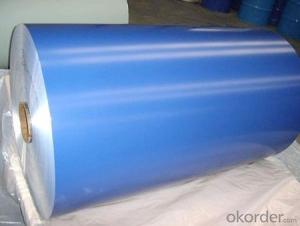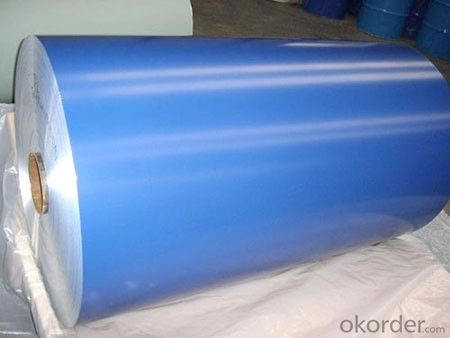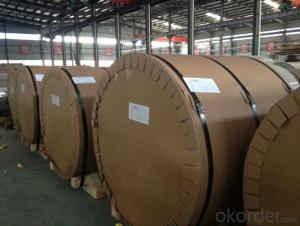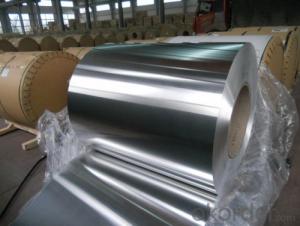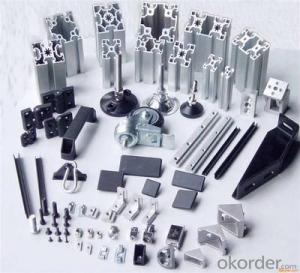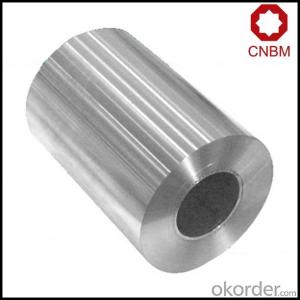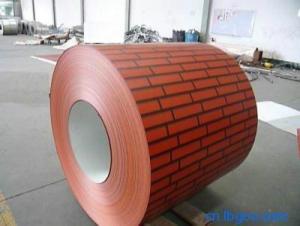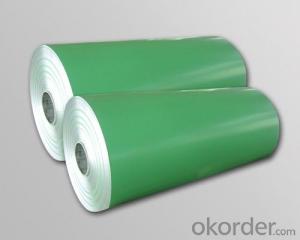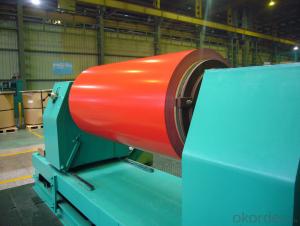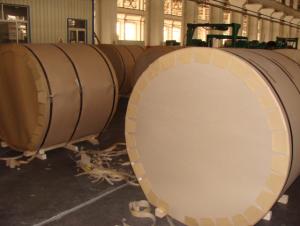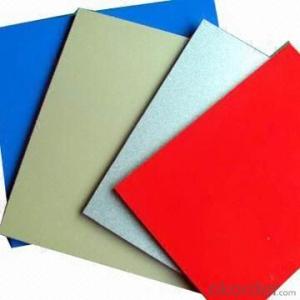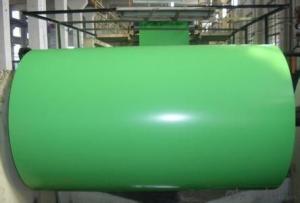Green Aluminum Coil - PVDF Coated Aluminum Coil-AA 8xxx
- Loading Port:
- China Main Port
- Payment Terms:
- TT OR LC
- Min Order Qty:
- -
- Supply Capability:
- -
OKorder Service Pledge
OKorder Financial Service
You Might Also Like
Product Description:
1 Specifications of PVDF Coated Aluminum Coil/Sheet
Alloy | AA1050,AA1060, AA1070, AA1100, AA3003, AA3004, AA3005, AA3105, AA5005, AA5052, AA5754, AA5083, AA8011 |
Temper: | H12, H14, H16, H18, H22, H24, H26, H32,HO, F |
Thickness: | 0.10-4.0mm |
Width: | 10mm- 2000mm |
Coating | PVDF |
Painting Thickness | Standard 16-25 microns, max 40 microns |
Color | Acording to Ral colors or customer’s samples |
Standard: | GB/T17748-1999, ASTM, ISO, EU standard |
Special Specification is available on customer’s requirement | |
PVDF(fluorine-carbon) Coating
PVDF(fluorine-carbon) coating :made of fluorine carbon resin, pigment, ester solvent, after high temperature roasting and baking, the paint is solidified to dry film with super weather resistance. PVDF coating also can be classified as traditional PVDF and nanometer PVDF coating.
A.Traditional PVDF Coating, with KYNAR500 PVDF, two or three times for coating and baking, has good properties of anti-acid, anti-alkali and is durable in atrocious weather and environment, keeping 15 years no unwonted fading. In view of these facts, we recommend this panel applied for external wall cladding.
B.Nanometer PVDF Coating, which different with traditional PVDF is the clear coating. It contains nanometer element, which can protect panel from pollution, Because nanometer has self-cleaning effect, It easy to get rid of dust and pollution by raining or water.
- Q: Can aluminum coils be used for gutter systems?
- Indeed, gutter systems can employ aluminum coils. The lightweight property, durability, and resistance to rust and corrosion make aluminum a favored material for gutters. It is common practice to utilize aluminum coils to shape seamless gutters, which present benefits such as reduced leakage and an enhanced visual appeal. Moreover, maintaining aluminum gutters is effortless, and they can be painted to harmonize with a building's exterior. All in all, aluminum coils are a fitting and frequently employed option for gutter systems.
- Q: How are aluminum coils cut and shaped?
- Aluminum coils are cut and shaped using various methods and tools, depending on the desired shape and size. The most commonly used techniques include slitting, shearing, and laser cutting. Slitting is the process of cutting a wide coil into narrower strips. It involves feeding the coil through a set of circular blades that make precise cuts along the length of the coil. This method is commonly used to produce thin strips of aluminum that are then further processed or used in various applications. Shearing is another common method used to cut aluminum coils. It involves using a machine with a moving blade to cut through the coil. The blade applies pressure to the coil, resulting in a clean and straight cut. Shearing is often used for cutting thicker aluminum coils and is suitable for producing straight cuts without any deformation. Laser cutting is a more advanced technique used to cut and shape aluminum coils. It involves using a high-powered laser beam to melt or vaporize the metal along a predetermined path. This method offers high precision and allows for complex shapes and designs to be cut into the aluminum. Laser cutting is commonly used in industries where intricate and detailed cuts are required. After the cutting process, the aluminum coils can be further shaped using various methods such as bending, rolling, stamping, or forming. These techniques allow the aluminum to be shaped into different geometries and forms according to the specific requirements of the desired application. Overall, the cutting and shaping of aluminum coils involve a range of techniques and tools, each suited for different requirements. The chosen method depends on factors such as the thickness of the coil, the desired shape, and the precision needed for the final product.
- Q: How to purchase PE polyester coated aluminum sheet and PVDF fluorocarbon coated aluminum coil?
- Both belong to color coated aluminum sheet and coil. Customers can purchase ordinary aluminum sheet or coil, and then go to special coating company to add PE polyester coating or PVDF fluorocarbon coating. The color is bright and quality is also very good. PE polyester coated aluminum and PVDF fluorocarbon coated aluminum coil has a wide range of usages: construction industry (aluminum-plastic panel, aluminum honeycomb, roof corrugated sheet, fireproof veneer, aluminum ceiling, shutter, rolling shutter door, garage door, awning, water gutter), electronic appliances (computer chassis, computer panel), lighting, furniture, solar reflector, air conditioning duct and the like. At present it is still applied in many areas including electronic appliance, instrument, lighting, packaging and house decoration.
- Q: How are aluminum coils different from steel coils?
- Aluminum coils and steel coils differ in several aspects. Firstly, aluminum is a lighter metal than steel, which means that aluminum coils are significantly lighter than their steel counterparts. This makes aluminum coils easier to handle and transport, reducing the overall weight of the final product. Secondly, aluminum has a higher corrosion resistance compared to steel. Steel coils are prone to rust and corrosion over time, especially when exposed to moisture or harsh weather conditions. On the other hand, aluminum coils have a natural oxide layer that acts as a protective barrier against corrosion, making them more durable and long-lasting. Furthermore, aluminum has a higher thermal conductivity than steel. This means that aluminum coils can transfer heat more efficiently, making them ideal for applications that require excellent heat dissipation. Steel, being a poor conductor of heat, is less effective in dissipating heat and may retain heat for longer periods. Another significant difference is the aesthetic appeal. Aluminum coils have a natural silver-gray color, giving them a sleek and modern look. Steel coils, on the other hand, are typically coated or painted to enhance their appearance and protect them from corrosion. Lastly, the cost factor plays a role in distinguishing aluminum and steel coils. Aluminum is generally more expensive than steel, mainly due to the higher production costs associated with aluminum extraction and processing. However, the long-term benefits of using aluminum coils, such as lower maintenance and replacement costs due to its corrosion resistance, can offset the initial higher investment. In summary, aluminum coils differ from steel coils in terms of weight, corrosion resistance, thermal conductivity, aesthetics, and cost. These differences make aluminum coils a popular choice in various industries where lightness, durability, heat dissipation, and corrosion resistance are crucial factors.
- Q: Is it safe and effective to use aluminum coil for baking purposes?
- <p>Yes, aluminum coil can be used for baking. It is a common material in baking due to its excellent heat conductivity, which allows for even heating and browning of baked goods. However, it's important to ensure that the aluminum coil is food-grade and clean to avoid any contamination. Additionally, some people may be concerned about potential health risks associated with aluminum, although these concerns are generally considered minimal when using aluminum cookware for baking.</p>
- Q: How are aluminum coils used in the manufacturing of appliances?
- Aluminum coils are used in the manufacturing of appliances as a key component in the production of heat exchangers. These coils are utilized for their excellent thermal conductivity, which enables efficient heat transfer between the appliance and its surroundings. The coils are shaped into a specific design and then integrated into appliances such as refrigerators, air conditioners, and heating systems to facilitate the cooling or heating process.
- Q: Is it safe to use steel wires for making jewelry or decorative items, and are there any potential health hazards associated with it?
- <p>Using steel wires for jewelry or decorations generally poses minimal health risks when used properly. However, there are a few considerations: allergic reactions can occur in individuals sensitive to nickel, which is often found in stainless steel. Additionally, improper use or sharp edges can lead to cuts or injuries. It's important to ensure that the steel is of high quality and that any jewelry made is smooth and free of sharp points to minimize the risk of injury. Regular cleaning and maintenance are also recommended to prevent any potential health risks associated with bacteria buildup or skin irritation.</p>
- Q: I'm asking about the aluminum tabs on soda cans. I've heard mixed things.
- Leave the tabs on the can when you bring the can to be recycled. You don't get any extra for them because they just aren't very valuable. You might want to tell the hospital that offering extra for the tabs isn't going help them and is just a waste of money.
- Q: What are the different coil handling equipment options for aluminum coils?
- When it comes to handling aluminum coils, there are several equipment options available that cater to the specific requirements and preferences of the user. Here are some commonly used options: 1. Coil Lifters: Specially designed lifting devices, coil lifters efficiently and securely handle aluminum coils. They typically consist of clamps or hooks attached to a lifting mechanism. Coil lifters can be manually operated or powered by electricity or hydraulics, ensuring ease of use and increased productivity. 2. Coil Tippers: Used for rotating or tilting aluminum coils, coil tippers facilitate loading, unloading, and positioning. Equipped with adjustable arms or clamps, they securely hold the coil during rotation. Control options include manual or hydraulic and electric systems for precise movements. 3. Coil Cars: Coil cars are transport vehicles designed for moving aluminum coils within a manufacturing facility or between areas. They have a platform or carriage where the coil is placed, and various mechanisms for loading, unloading, and positioning. Coil cars can be manually operated or powered by electricity or hydraulics, enhancing efficiency. 4. Coil Turnstiles: For safe and efficient storage and retrieval of aluminum coils in a vertical position, coil turnstiles are used. They typically consist of a rotating drum or spool capable of holding multiple coils, providing easy access. Coil turnstiles can be manually operated or powered by electricity or hydraulics, offering quick and convenient storage solutions. 5. Coil Cradles: Coil cradles are used to support and protect aluminum coils during storage or transportation. They feature a sturdy frame or structure with adjustable arms or supports that securely hold the coil. Coil cradles can be customized to accommodate different coil sizes and weights, ensuring safe and stable handling. In conclusion, these coil handling equipment options offer various solutions for efficient and safe handling of aluminum coils, improving manufacturing processes and productivity. The choice of equipment depends on factors such as coil size, weight, specific operation requirements, and available budget.
- Q: What are the different types of aluminum coils?
- Aluminum coils come in a variety of types, each with its own unique properties and uses. Let's take a look at some common examples: 1. Pure Aluminum Coils: Made from pure aluminum, these coils find applications in packaging, construction, and automotive industries. 2. Textured Aluminum Coils: These coils have a surface with texture or patterns, adding aesthetic appeal and providing grip or anti-slip properties. They are commonly used in architectural designs, signage, and decorative applications. 3. Coated Aluminum Coils: These coils have a protective coating applied to the surface, offering enhanced durability, weather resistance, and aesthetic customization. They are often used in building facades, roofing, and cladding systems. 4. Anodized Aluminum Coils: Through an electrochemical process called anodization, a layer of oxide is formed on the surface of the aluminum, making it more resistant to corrosion and wear. Anodized aluminum coils are commonly used in architectural applications, electronics, and automotive parts. 5. Pre-painted Aluminum Coils: With a layer of paint applied to the surface, these coils provide protection against weathering and add color aesthetics. They are frequently used in the construction industry for roofing, siding, and insulation purposes. 6. Stucco Patterned Aluminum Coils: These coils have a raised pattern resembling stucco, adding texture and strength to the aluminum. They are commonly used in refrigerators, air conditioners, and other appliances. 7. Clad Aluminum Coils: These coils consist of two or more layers of aluminum bonded together, offering enhanced strength, durability, or specific properties. They find applications in industries such as aerospace, defense, and transportation. In summary, the choice of aluminum coil type depends on specific application requirements, including appearance, corrosion resistance, durability, and mechanical properties.
Send your message to us
Green Aluminum Coil - PVDF Coated Aluminum Coil-AA 8xxx
- Loading Port:
- China Main Port
- Payment Terms:
- TT OR LC
- Min Order Qty:
- -
- Supply Capability:
- -
OKorder Service Pledge
OKorder Financial Service
Similar products
Hot products
Hot Searches
Related keywords
